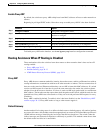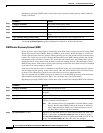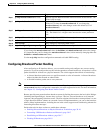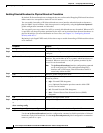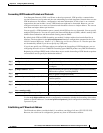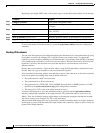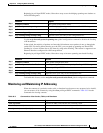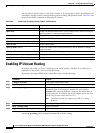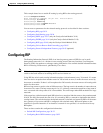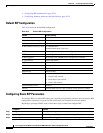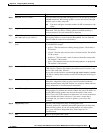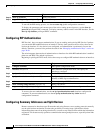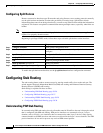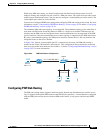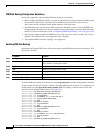
38-21
Cisco Catalyst Switch Module 3110 and 3012 for IBM BladeCenter Software Configuration Guide
OL-12189-01
Chapter 38 Configuring IP Unicast Routing
Configuring RIP
This example shows how to enable IP routing by using RIP as the routing protocol:
Switch# configure terminal
Enter configuration commands, one per line. End with CNTL/Z.
Switch(config)# ip routing
Switch(config)# router rip
Switch(config-router)# network 10.0.0.0
Switch(config-router)# end
You can now set parameters for the selected routing protocols as described in these sections:
• Configuring RIP, page 38-21
• Configuring Stub Routing, page 38-26
• Configuring OSPF, page 38-31 (only the Catalyst Switch Module 3110)
• Configuring EIGRP, page 38-41 (only the Catalyst Switch Module 3110)
• Configuring BGP, page 38-49 (only the Catalyst Switch Module 3110)
• Configuring Unicast Reverse Path Forwarding, page 38-85
• Configuring Protocol-Independent Features, page 38-85 (optional)
Configuring RIP
The Routing Information Protocol (RIP) is an interior gateway protocol (IGP) for use in small,
homogeneous networks. It is a distance-vector routing protocol that uses broadcast User Datagram
Protocol (UDP) data packets to exchange routing information. You can find detailed information about
RIP in IP Routing Fundamentals, published by Cisco Press.
Note RIP is the only routing protocol supported by the IP base feature set; other routing protocols require the
switch or the stack master to be running the IP services feature set.
Using RIP, the switch sends routing information updates (advertisements) every 30 seconds. If a router
does not receive an update from another router for 180 seconds or more, it marks the routes served by
that router as unusable. If there is still no update after 240 seconds, the router removes all routing table
entries for that router.
RIP uses hop counts to rate the value of different routes. The hop count is the number of routers that can
be traversed in a route. The hop count range is 0 to 15. A directly connected network has a hop count of
zero; a network with a hop count of 16 is unreachable. The small range makes RIP unsuitable for large
networks.
If the router has a default network path, RIP advertises a route that links the router to the pseudonetwork
0.0.0.0. The 0.0.0.0 network does not exist: It is treated by RIP as a network to implement the default
routing feature. The switch advertises the default network if a default was learned by RIP or if the router
has a gateway of last resort and RIP is configured with a default metric. RIP sends updates to the
interfaces in specified networks. If an interface’s network is not specified, it is not advertised in any
RIP update.
These sections contain this configuration information:
• Default RIP Configuration, page 38-22
• Configuring Basic RIP Parameters, page 38-22



